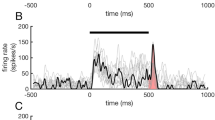Abstract
IF a rat is anaesthetized with urethane (1.8 g/kg given intraperitoneally) and prepared for microelectrode recording from the cerebral cortex1, cells discharge in bursts. The mean frequency, that is, total number of spikes/s, of these bursts of firing will stay constant for many hours provided the animal is not stimulated in any way and kept at a steady temperature. The passage of a polarizing current between a wick on the cortical surface and an indifferent electrode in the orbit, so that the cortical surface is positive with respect to the indifferent, will cause the rate of discharge of the cells to be increased. Furthermore, if the current maintains the increased rate of discharge for more than 5 min then, on turning the current off, the discharge rate does not return to the preexisting value but remains at an increased level1. I shall refer to this prolonged increase in activity as an “aftereffect” for convenience. Bindman2 and I and Lippold3 have shown that the after-effect is a result of the increase in neuronal discharge rate during stimulation and not of the specific nature of the stimulus itself.
This is a preview of subscription content, access via your institution
Access options
Subscribe to this journal
Receive 51 print issues and online access
$199.00 per year
only $3.90 per issue
Buy this article
- Purchase on Springer Link
- Instant access to full article PDF
Prices may be subject to local taxes which are calculated during checkout
Similar content being viewed by others
References
Bindman, L. J., Lippold, O. C. J., and Redfearn, J. W. T., J. Physiol., 172, 369 (1964).
Bindman, L. J., J. Physiol., 179, 14P (1965).
Gartside, I. B., and Lippold, O. C. J., J. Physiol., 189, 475 (1967).
Li, C. L., Ohta, T., Ojemann, G., and Parker, L., Exp. Neurol., 20, 533 (1968).
Leão, A. A. P., J. Neurophysiol., 7, 359 (1944).
Author information
Authors and Affiliations
Rights and permissions
About this article
Cite this article
GARTSIDE, I. Mechanisms of Sustained Increases of Firing Rate of Neurones in the Rat Cerebral Cortex after Polarization: Reverberating Circuits or Modification of Synaptic Conductance?. Nature 220, 382–383 (1968). https://doi.org/10.1038/220382a0
Received:
Published:
Issue Date:
DOI: https://doi.org/10.1038/220382a0
This article is cited by
-
Non-Invasive Brain Stimulation Combined with Neuromuscular Electrical Stimulation for Upper Limb Rehabilitation in Stroke Survivors: A Systematic Review
Current Physical Medicine and Rehabilitation Reports (2024)
-
Neuromodulation for temporal lobe epilepsy: a scoping review
Acta Epileptologica (2022)
-
Effects of different transcranial direct current stimulation protocols on visuo-spatial contextual learning formation: evidence of homeostatic regulatory mechanisms
Scientific Reports (2020)
-
Transcranial Direct Current Stimulation for the Treatment of Depression: a Comprehensive Review of the Recent Advances
International Journal of Mental Health and Addiction (2017)
-
Cerebellum as a forward but not inverse model in visuomotor adaptation task: a tDCS-based and modeling study
Experimental Brain Research (2016)
Comments
By submitting a comment you agree to abide by our Terms and Community Guidelines. If you find something abusive or that does not comply with our terms or guidelines please flag it as inappropriate.



